Contents
Introduction
The Standard Model of particle physics is our best description of the fundamental building blocks of our universe. It describes the elementary particles, the ways they can combine, and how they interact with each other through the four fundamental forces.
In this post, we’re going to focus on the elementary particles of the Standard Model which are the most basic ingredients of our universe.
Let’s begin!
Three families of elementary particles
There are three families of elementary particles: the quarks, the leptons and the elementary bosons. Each family has six members:
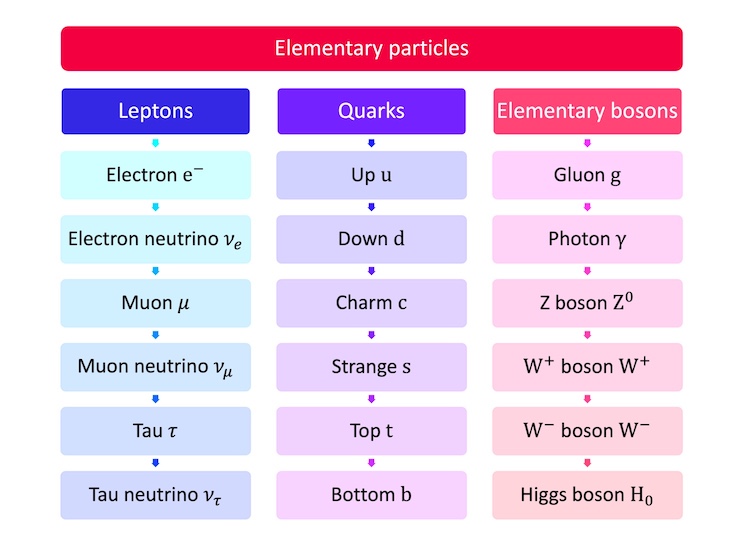
The elementary particles are usually shown in the following arrangement which you may have seen before:
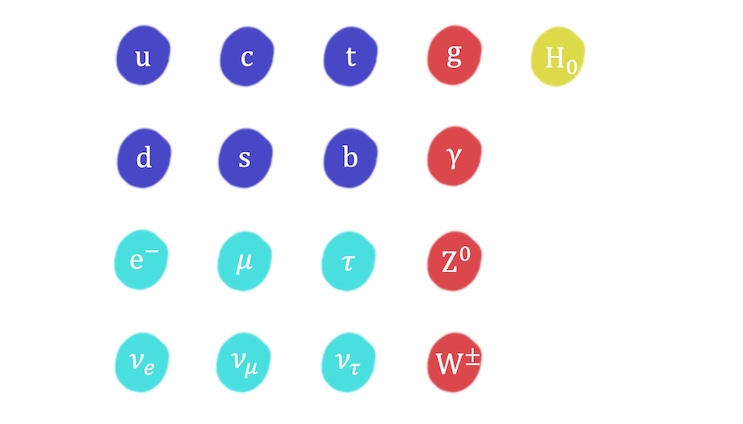
In this arrangement, the particles are grouped together in their families, and the elementary bosons can be further divided into two sub-groups: the force carrying bosons and the Higgs boson.
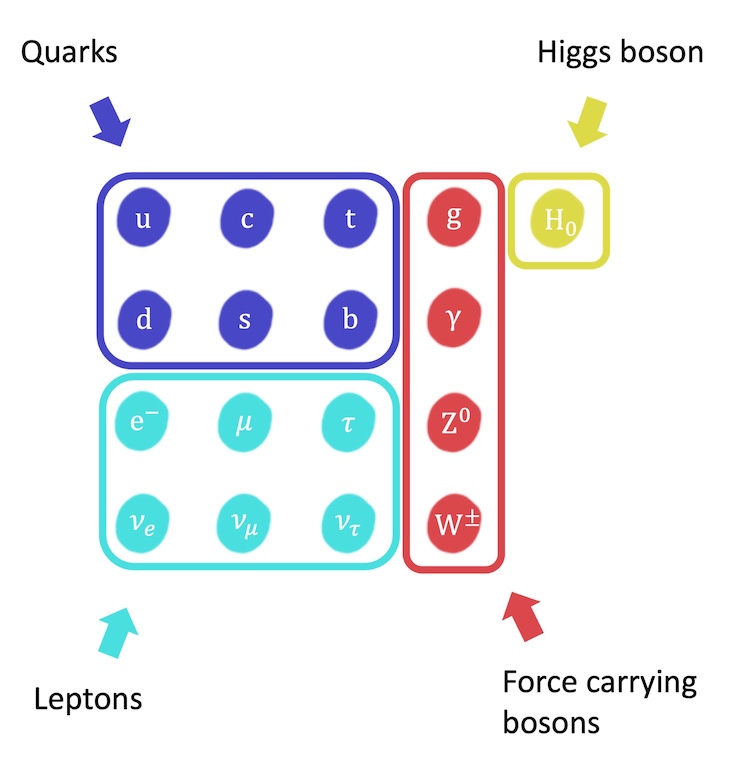
What are quarks?
Let’s take a detailed look at the quarks.
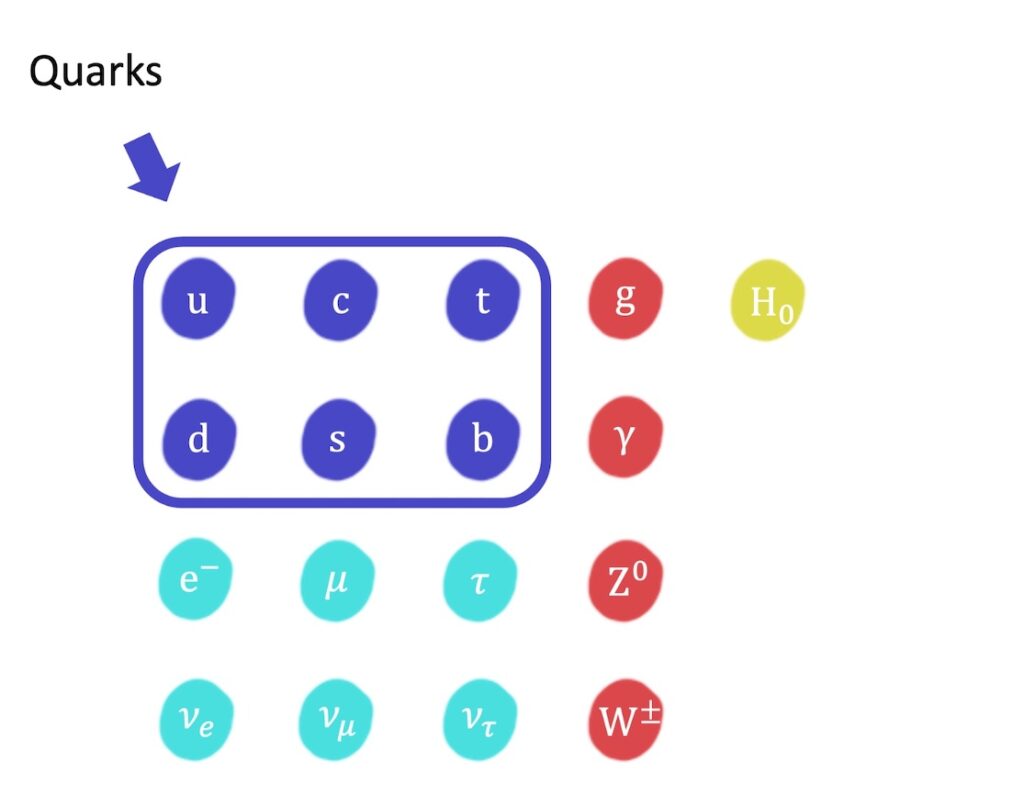
The quark family contains three pairs of quarks: the up and down quarks, the charm and strange quarks, and the top and bottom quarks.

The pairs of quarks are shown in order of increasing mass.
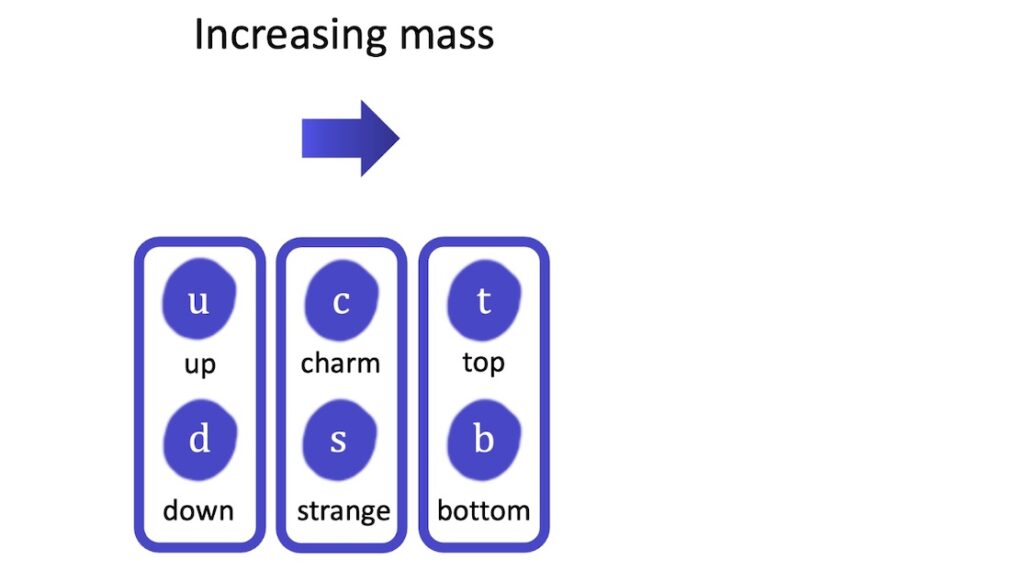
There is a wide range of masses in this family, starting from a modest \(0.0023 \, \mathrm{GeVc^{-2}}\) for the up quark to a whopping \(173 \, \mathrm{GeVc^{-2}}\) for the bottom quark. The bottom quark is the heaviest of all the elementary particles.
Their charges also follow a pattern. The first quark of each pair has a charge of \(2 \big/ 3\), while the second quark of each pair has a charge of \(-1 \big/ 3\).
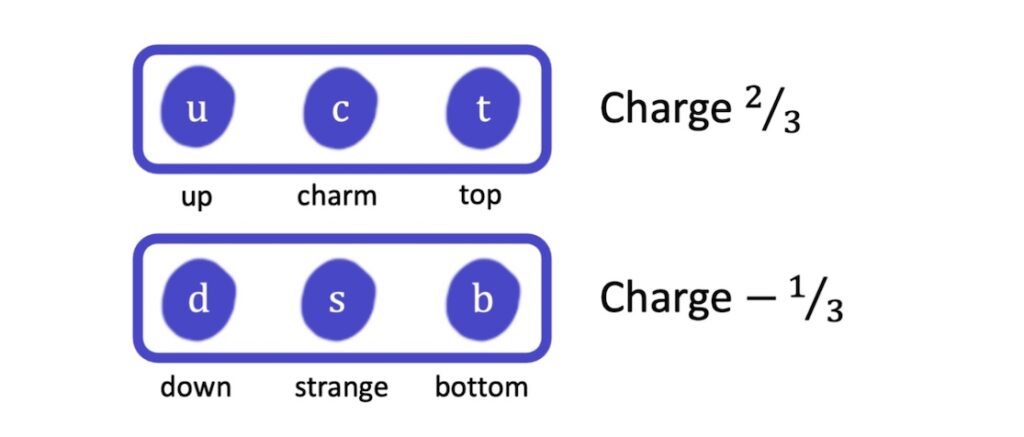
All quarks have a spin of \(1 \big/ 2\).
There is another special property you should know about for the quarks: strangeness. The strange quark has a strangeness of \(-1\) and all other quarks have a strangeness of \(0\).
These properties of the quarks are summarised as follows:
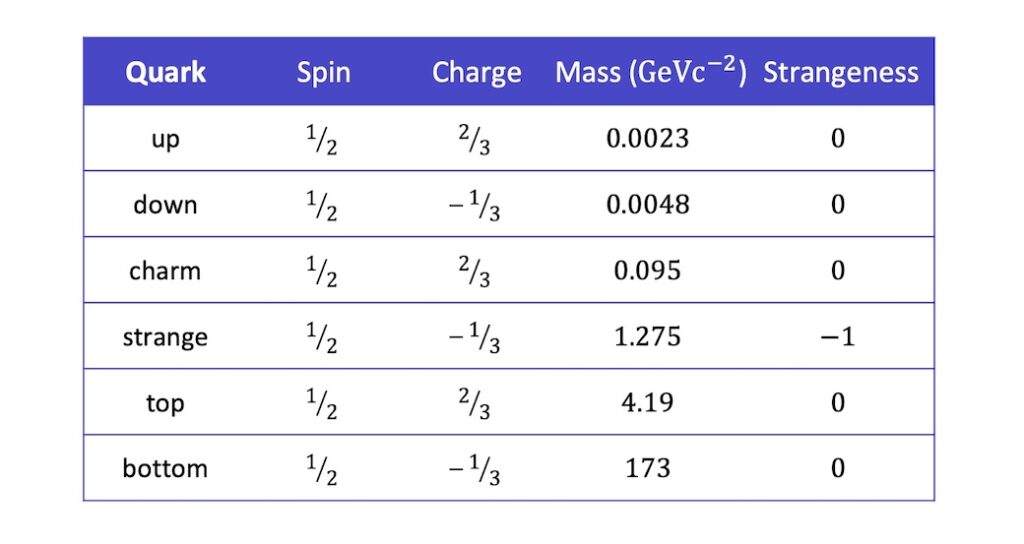
The quark family plays an important role in everyday matter because the up and down quarks can combine to form the proton and neutron of the atomic nucleus. It’s interesting to note that the two quarks playing this role are the lightest, and therefore the most stable.
What are leptons?
Now let’s take a look at the leptons.
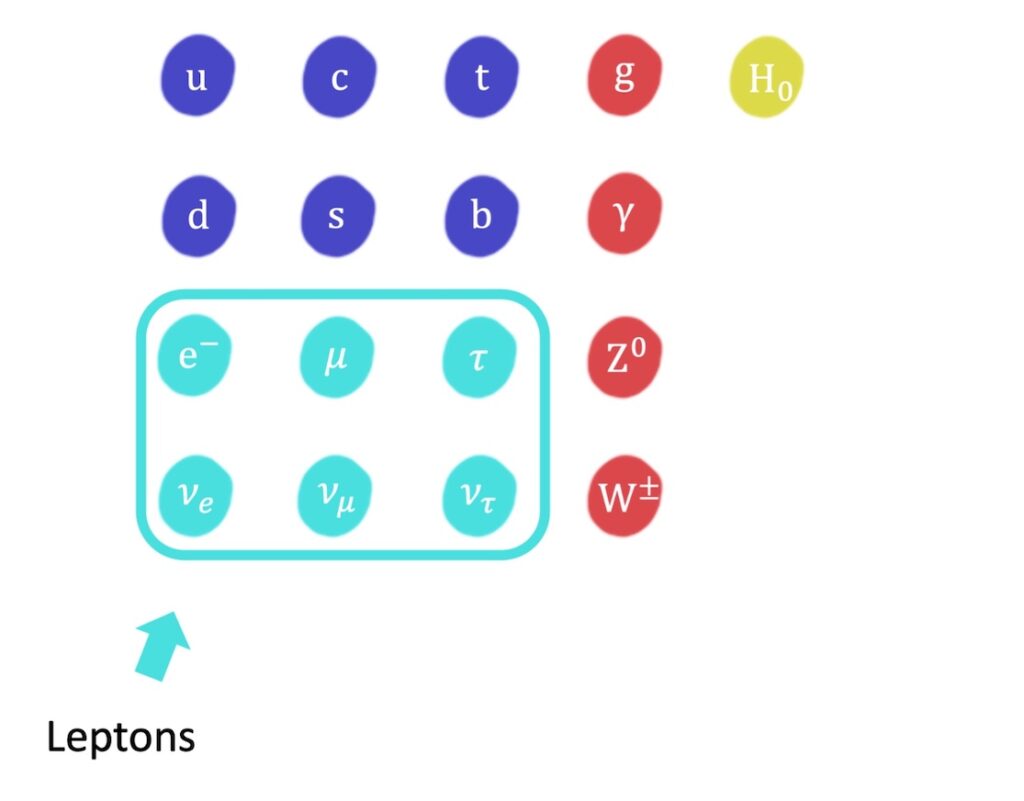
You may have noticed that the lepton family includes the familiar electron! This family also includes the electron’s sister particles, the muon and the tau, together with their respective neutrinos: the electron neutrino, the muon neutrino and the tau neutrino. The lepton family can also be divided into three pairs, each pair consisting of an electron-like particle and a corresponding neutrino.
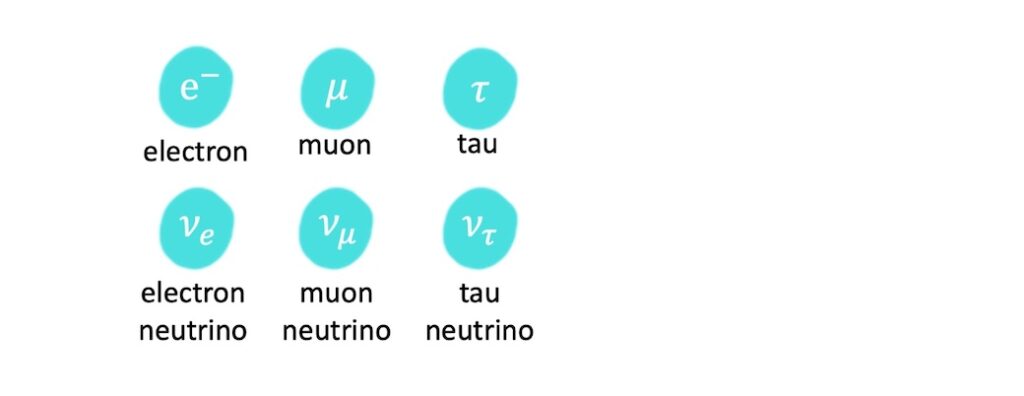
In the same way as the quarks, the pairs of leptons are shown in order of increasing mass.
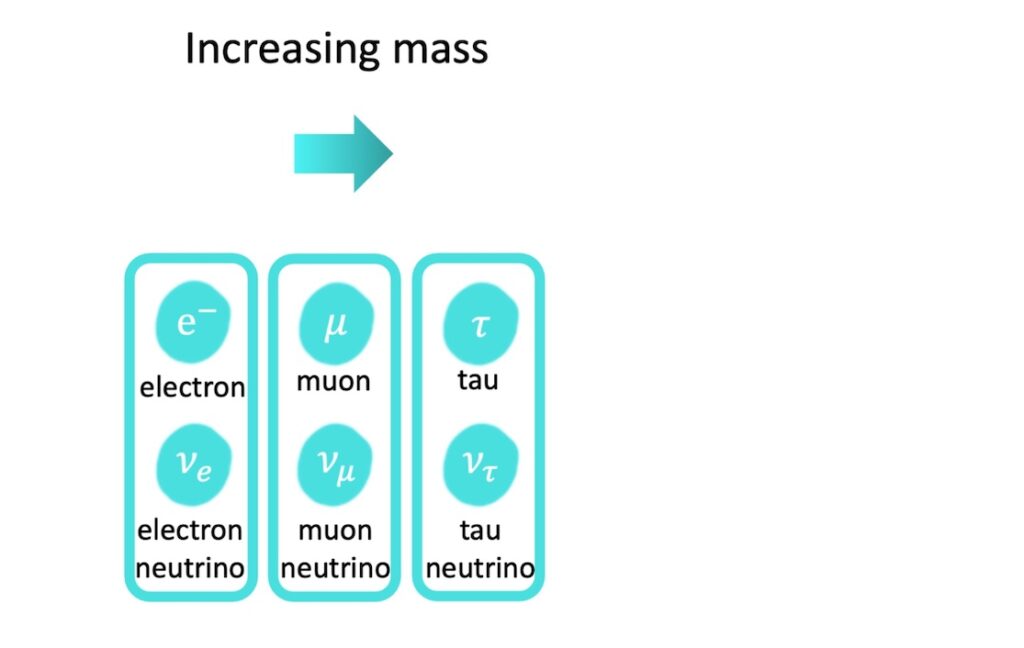
However, in the lepton family the neutrinos are much lighter than their electron-like counterparts. While the electron-like leptons range in mass from a modest \(0.511 \, \mathrm{MeVc^{-2}}\) for the electron to a reasonably hefty \(1780 \, \mathrm{MeVc^{-2}}\) for the tau, their respective neutrinos are much lighter, with the electron neutrino being extremely lightweight at under \(2.2 \times 10^{-6} \, \mathrm{MeVc^{-2}}\).
The electron-like leptons each have a charge of \(-1\) and the neutrinos are chargeless.
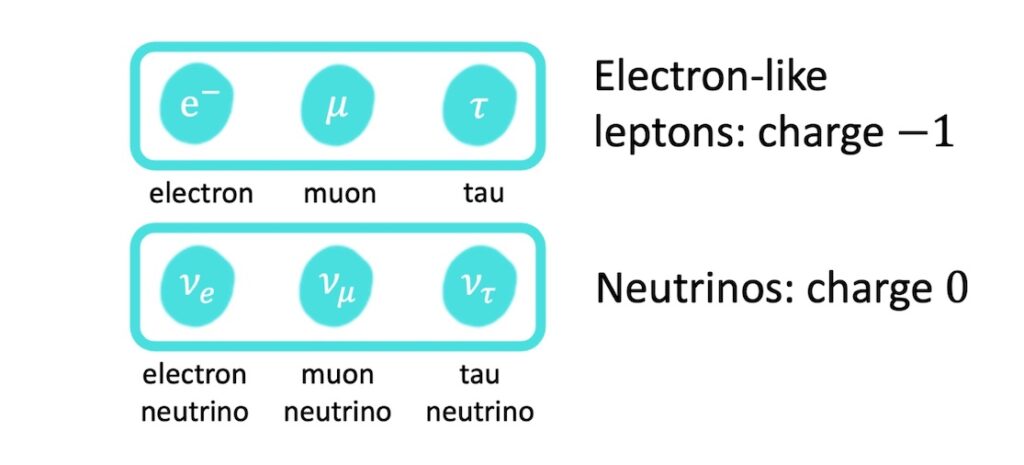
Like quarks, all leptons have a spin of \(1 \big/ 2\).
Leptons have a special property called lepton number. Each lepton has a lepton number of \(1\) and all other particles have a lepton number of \(0\).
These properties of the leptons are summarised as follows:
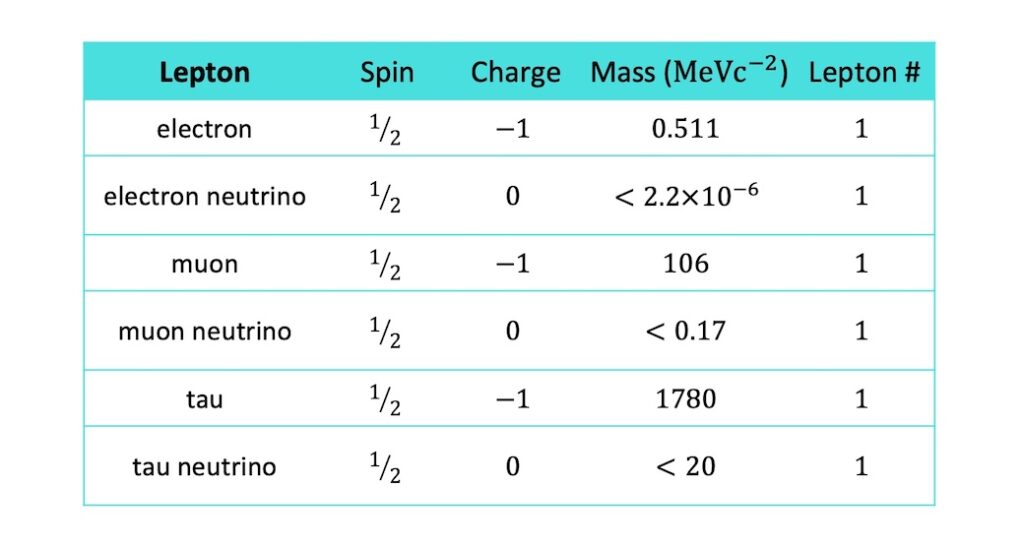
The most significant lepton for everyday matter is, of course, the electron. This is the lightest and most stable of the electron-like leptons.
The neutrinos are also lightweight particles that exist stably in nature. They do not, however, contribute to everyday matter and they are difficult to detect. It is for this reason that their exact masses are not known.
The force carrying bosons
Now let’s take a closer look at the force carrying bosons.
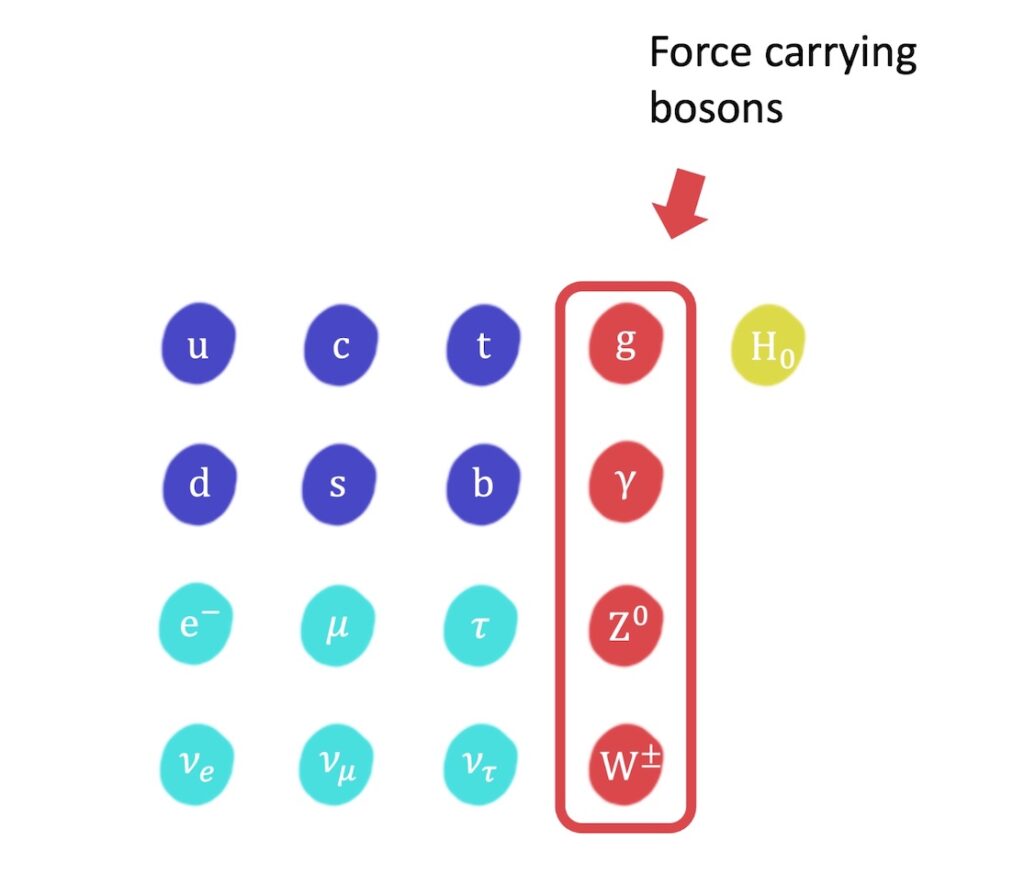
There are five known force carrying bosons: the gluon, the photon, and the \(\mathrm{Z^0}\), \(\mathrm{W^+}\) and \(\mathrm{W^-}\) bosons. (The \(\mathrm{W^+}\) and \(\mathrm{W^-}\) bosons are often written together as \(\mathrm{W^\pm}\).)
These mediate three of the four fundamental forces: the gluon mediates the strong nuclear force, the photon mediates the electromagnetic force, and the \(\mathrm{Z^0}\), \(\mathrm{W^+}\) and \(\mathrm{W^-}\) bosons each mediate the weak nuclear force.
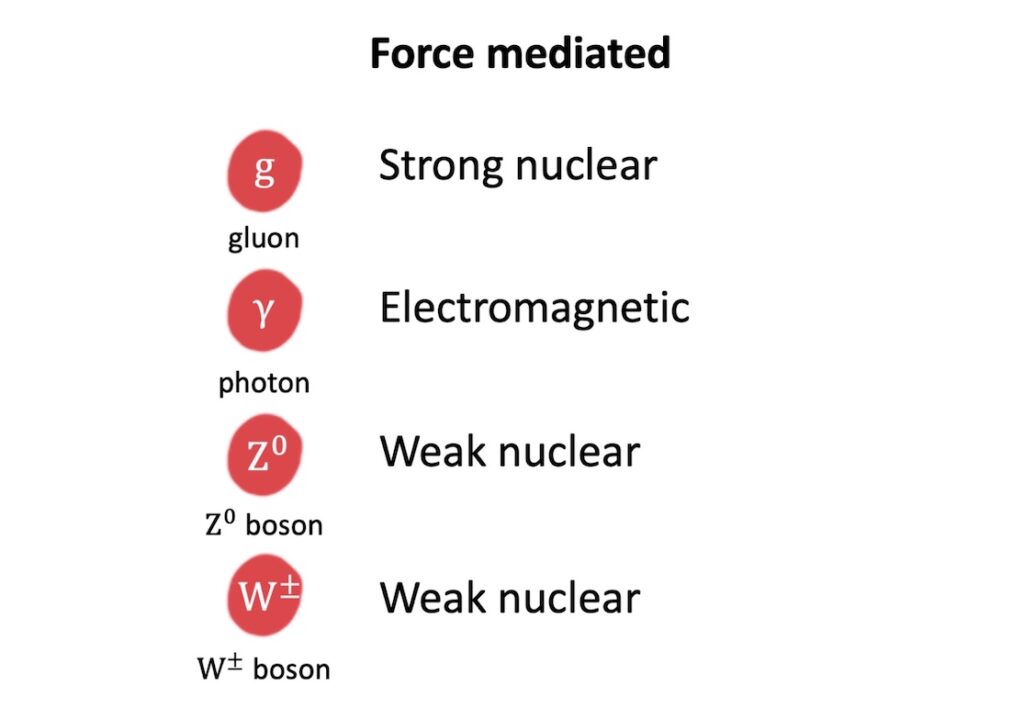
The hypothetical graviton (not shown) is thought to mediate the gravitational force, but this particle has not yet been experimentally detected.
The force carrying bosons have some interesting properties. While the gluon and the photon are both massless, the \(\mathrm{Z^0}\), \(\mathrm{W^+}\), \(\mathrm{W^-}\) bosons are some of the heaviest of all the elementary particles. The gluon and the photon are the only massless particles in the Standard Model.
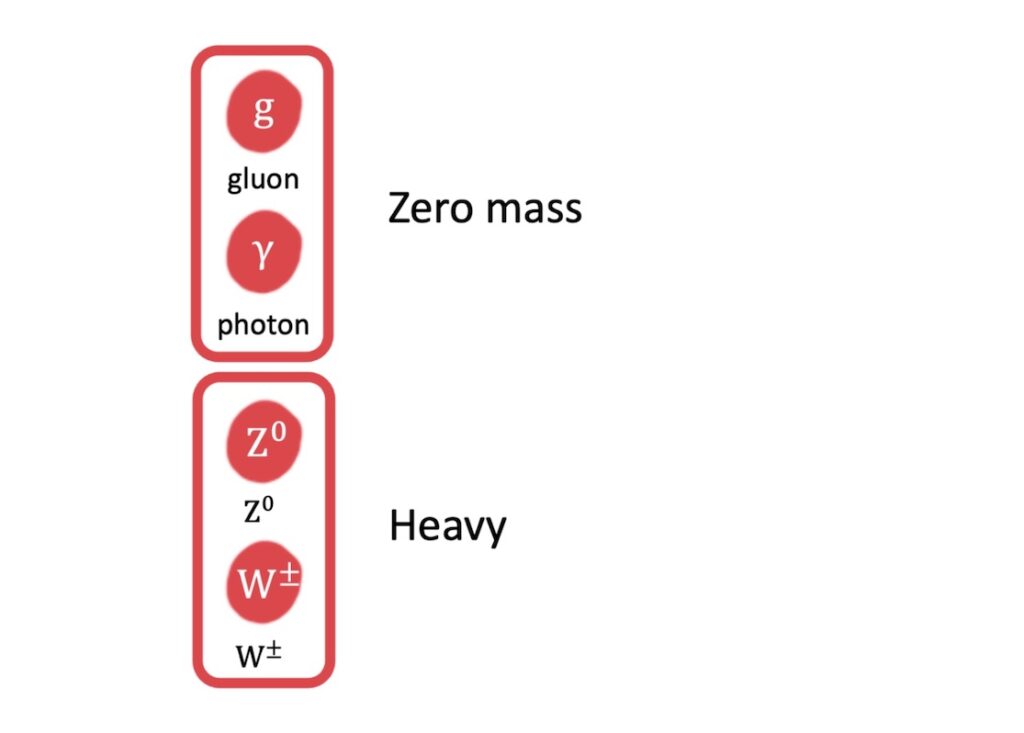
Meanwhile, the gluon, photon and \(\mathrm{Z^0}\) boson are chargeless, and the \(\mathrm{W^+}\) and \(\mathrm{W^-}\) bosons have a charge of \(1\) and \(-1\), respectively.
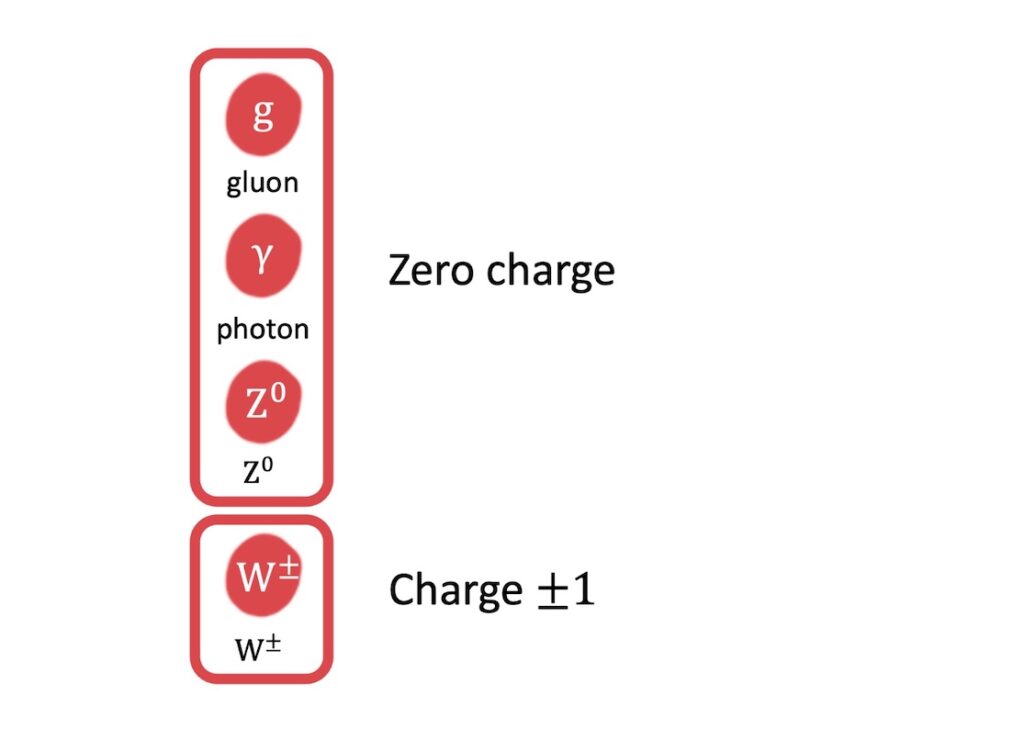
All force carrying bosons have a spin of \(1\).
These significantly varying properties of the force carrying bosons, as well as the forces they mediate, are summarised as follows:
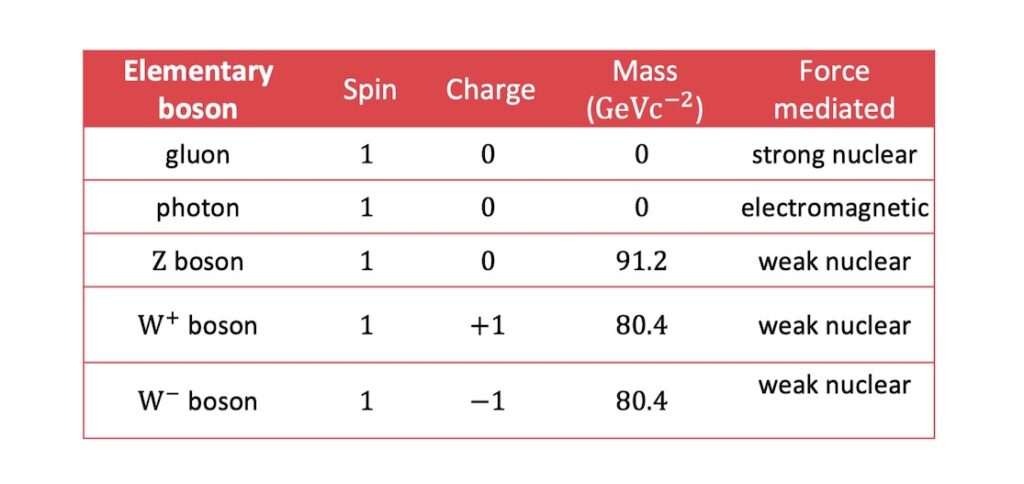
The Higgs boson
The elementary bosons also include the famous Higgs boson.
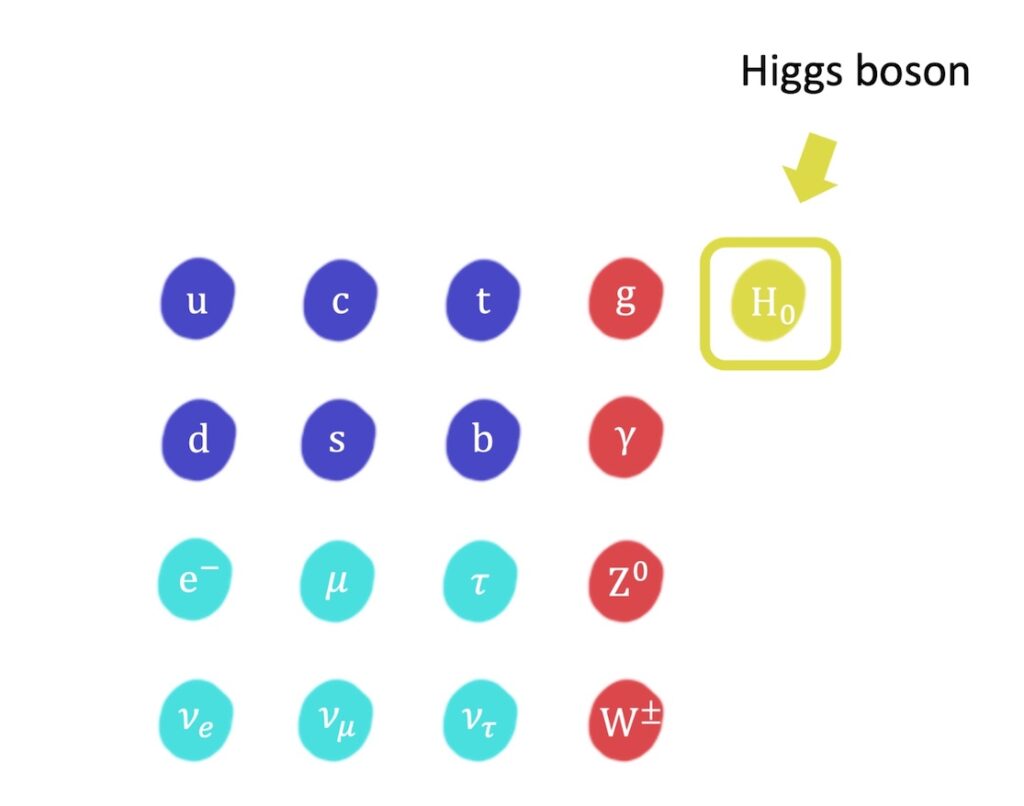
Unlike the other elementary bosons, this particle does not mediate a force. Its role is somewhat mysterious, but it is thought to give many particles their mass.

It has a mass itself, and is a heavyweight being the second heaviest elementary particle, lighter only than the bottom quark.
It is chargeless and has zero spin.
These properties of the Higgs boson are summarised as follows.

Conclusion
I hoped you’ve enjoyed this review of the properties of the elementary particles! It is remarkable to think that these particles are the building blocks for everything in our universe.
Now that you have an understanding of the elementary particles, you might like to see how quarks combine to form hadrons, review the system of classification of particles in the Standard Model, or explore in more detail the four fundamental forces.
Happy studying!
